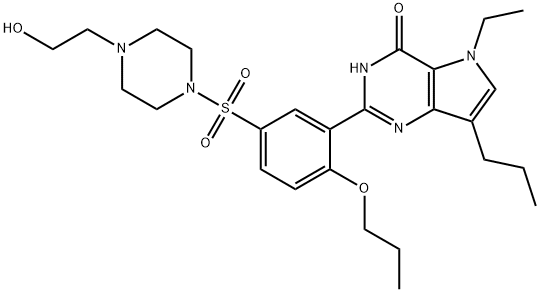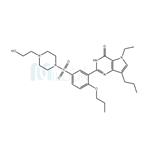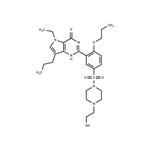Mirodenafil (Mvix), a second-generation PDE5i, was launched in Korea in November 2007, and its orally dissolving film (Mvix S) was launched in December 2011. The product is available in tablet formulation or orally dissolving film of 50 and 100 mg. Mirodenafil has been approved only in Korea. Its pharmacokinetic profiles include a Tmax of 1.25 h, T1/2 of 2.5 h, and a IC50 for PDE5 of 0.34 nmol/L, which would confer a biochemical property of relatively high affinity (potency) for PDE5. While the pharmacokinetic profile is similar to that of sildenafil, mirodenafil appears to be 10 times more selective for PDE5 than sildenafil.
Mirodenafil has been used in trials studying the treatment and supportive care of Kidney Diseases, Urologic Diseases, Renal Insufficiency, Erectile Dysfunction, and Male Erectile Dysfunction.
ChEBI: Mirodenafil is a member of the class of pyrrolopyrimidines that is 3,5-dihydro-4H-pyrrolo[3,2-d]pyrimidin-4-one having a 5-{[4-(2-hydroxyethyl)piperazin-1-yl]sulfonyl}-2-propoxyphenyl group at positon 2, ethyl group at position 5, and a propyl group at position 7. It is a phosphodiesterase type 5 inhibitor which is used for the treatment of erectile dysfunction. It has a role as an EC 3.1.4.35 (3',5'-cyclic-GMP phosphodiesterase) inhibitor and a vasodilator agent. It is a sulfonamide, a pyrrolopyrimidine, a N-alkylpiperazine, a primary alcohol and an aromatic ether.
Mirodenafil (SK3530) is an orally active, highly potent and selective phosphodiesterase-5 (PDE5) inhibitor (IC50 = 338 pM). with therapeutic efficacy in various ED models in vivo. Comparing to sildenafil, mirodenafil shows ~10-times higher PDE5 selectivity in vitro and remains longer in the plasma and corpus cavernosum following oral dosing at 40 mg/kg in rats in vivo.



